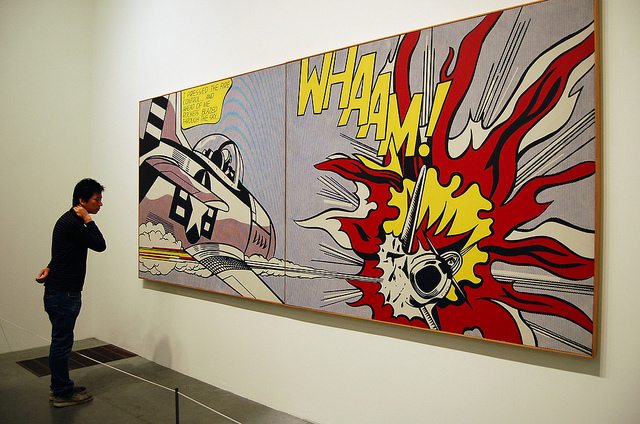
Source: Irony, pschemp, Wikimedia
How many times have you heard “it’s just a figure of speech”? Did you ever wonder what that meant? Take a look at the picture. It contains a dead end sign in front of a cemetery–an example of irony. The sign is ironic because its intention is to tell drivers that that a road has literally ended, but in this case, the sign sends a more ominous (and possibly humorous) message because of its placement at the edge of a cemetery. The intended meaning of the sign—the end of a road—now refers to the end of life.
Irony is one of the figures of speech that you will learn about in this section, along with several others. You will learn how figures of speech function within the sentence patterns of clauses and phrases and how writers use figurative language in conjunction with syntax to make their writing engaging for readers.
Read through the examples of commonly used figures of speech.
Alliteration
Alliteration is the same sound repeated at the beginning of words located close together. Writers often use alliteration to make their writing more catchy and lyrical.
Touch each object you want to touch as if tomorrow your tactile sense would fail.
Pay attention to how the author uses the hard ‘t’ sound to enhance her writing. Try saying the sentence out loud to yourself, and the effect becomes clearer. Helen Keller is asking you to touch an object as though you may be touching it for the last time, so she emphasizes the ‘t’ to make her point.
Parallelism
Parallelism is the expression of two ideas of equal importance through similar phrasing.
From Gettysburg to the blockbuster, a thousand times more explosive energy; from the blockbuster to the atomic bomb, a thousand times more; from the atomic bomb to the hydrogen bomb, a thousand times still more. A thousand times a thousand, times a thousand is a billion; in less than one century, our most fearful weapon has become a billion times more deadly. But we have not become a billion times wiser in the generations that stretch from Gettysburg to us.
Look at the text in bold print. The parallel structure shows the reader how much the problem has grown over the years: “a thousand times more; a thousand times still more.” To further make his point, Sagan jumps from a thousand to a billion, indicating how much worse the situation has become.
In this excerpt, Sagan also uses parallelism when he states that, from the time of the Battle of Gettysburg and the Civil War to the modern age, humankind has developed atomic weapons a billion times more deadly. He uses parallelism to build a timeline of increasingly destructive weaponry invented by humans using both historical and mathematical terms. Notice that each step of the historical timeline begins with “from” and contains “to.” Repeating this structure–“from x to y”–helps us follow Sagan’s timeline and understand what he is saying.
Metaphor
Metaphor is an indirect comparison between objects, events, or actions that are essentially unlike. Writers use metaphorical language to make their writing more vivid, imaginative, thought-provoking, and meaningful.
In so-called middle age, my mother’s hair never moved, never blew, never fell in her face: her hair became a museum piece. When she went to bed, she wore a blue net, and when she took short showers, short because, after all, she wasn’t washing her hair and she was seldom dirty, she wore a blue plastic cap for the sake of preservation.
The writer compares her mother’s hair to a “museum piece” and uses the word “preservation” to extend the metaphor.
Antithesis
Antithesis uses parallel sentence structure to contrast a phrase or idea with its direct opposite. Typically, writers use antithesis to emphasize points they are trying to make.
That’s one small step for man, one giant leap for mankind.
In this statement two contrasting ideas are being expressed by using similar phrasing or parallel structure: a small step for one man and giant leap for all of mankind.
Irony
Irony is the suggested difference between what is said or the literal meaning and what is meant. You may recall this definition from the opening of this section.
Aside from being the largest ship in the world at the time, the Titanic was on her maiden voyage. Just four days before the news of the disaster was flashed around the world, newspapers everywhere had printed the news of the Titanic’s sailing for New York from Southhampton. She was considered the last word in safety, efficiency, and luxuriance of equipment, and the eyes of the world were upon her. Had she made a safe passage, her entrance into New York Harbor would have been an event of great importance. Therefore, when it was learned that she had gone to the bottom of the ocean, the world was astounded. The calamity was of such unprecedented proportions that it seemed beyond the realm of possibility.
The first statement in this passage is an example of irony because the famous Titanic, which was considered to be ‘unsinkable’ by so many, sunk. The Titanic was designed by experienced engineers, using some of the most advanced technologies and extensive safety features of the time. The ship had ample stability, the design being such that there was very little risk of unequal flooding and possibly capsizing.
Onomatopoeia
Onomatopoeia looks like a complicated word, but it’s actually a fun word. Click below to find out how to pronounce it. Onomatopoeia occurs when words imitate the sound they represent, such as “whoosh” or “zing.”
The sound of a French bee, a cheerful ‘beeee-eeeep!,’ is the greeting at bzzzpeek.com, a Web site devoted to onomatopoeia.
Click on the link, wait a few seconds and you will hear the greeting--a “bbeeee-eeeep!” In this example, the word “beep” represents the sound French bees make. Click on the various objects around the edge of the photo to hear the noise as it is represented in various countries. Notice that each animal or object includes the colors and patterns of the country’s flag.

Source: “Whaam!” by Roy Lichtenstein, jpellgen, Flickr
Simile
Simile is a comparison between things, events, or actions, which are fundamentally unlike. Unlike metaphor, a simile almost always uses “like” or “as” in the comparison.
Read the following excerpt from Virginia Woolf’s “The Death of the Moth.” It is a good example of how writers use similes to add to their writing.
The rooks too were keeping one of their annual festivities; soaring round the tree tops until it looked as if a vast net with thousands of black knots in it had been cast up into the air; which, after a few moments sank slowly down upon the trees until every twig seemed to have a knot at the end of it. Then, suddenly, the net would be thrown into the air again in a wider circle this time, with the utmost clamour and vociferation, as though to be thrown into the air and settle slowly down upon the tree tops were a tremendously exciting experience.
In the first sentence, Woolf compares the rooks in their flight to a vast net cast or thrown up into the sky. If you close your eyes, you can almost see the net of birds moving up and down in the skies. The “as if” should have signaled to you the possibility of a simile.
What’s the Figure of Speech?
Read each example that follows and find the figure of speech. When you know the answer, choose it from the pull-down menu.
![]()
 Using your notes, think about the quote “To err is human, to forgive divine.” Explain why Alexander Pope chooses a specific figure of speech to make his point. When you’re finished writing, check your understanding to see a sample response.
Using your notes, think about the quote “To err is human, to forgive divine.” Explain why Alexander Pope chooses a specific figure of speech to make his point. When you’re finished writing, check your understanding to see a sample response. Sample Response:
Pope understands that everyone makes mistakes and will agree with the statement “To err is human.” By creating a consensus with the first part of this statement, he can gain acceptance for the second part, “to forgive divine.” Most importantly though, by using antithesis, Pope is able to show how humans can strive to be divine.